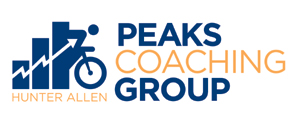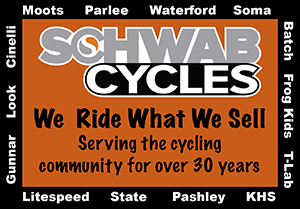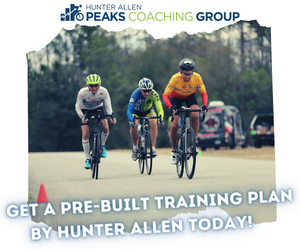

How to Successfully Train for a Stage Race
By Hunter Allen

Back to list of training, fitness and health articles

Bill & Carol McGann's book The Story of the Giro d'Italia, Vol 2: 1971 - 2011 is available as an audiobook here. For the print and Kindle eBook versions, just click on the Amazon link on the right.
Hunter Allen writes:
There are not many stage races here in the US, and the ones we have are usually only three to four days long. A longer stage race requires more fitness, more stamina and the ability to recover day after day. Most weekend races create just enough fatigue to feel sore and tired on Monday, but not enough to give you the sense of what a five day stage race might feel like. We all train smart. We all train hard. Do we all train hard enough for a demanding five+ day stage race? How fresh should you be when you enter the race? How tired do you expect to be in the last stage? What can you do about multi-day recovery and how you develop your fitness so that you can handle multi-day events?
The first thing you need to do after deciding that you are going to race in a longer stage race is to begin developing multi-day ‘recoverability’, so that you’ll be able to produce similar wattages day after day all the way to the final stage. We all fatigue, but those that recover quickly will ride stronger towards the end of a stage race. The racers that start with their ‘batteries’ 100% charged and then de-charge down to 80% by the end of the race, will do poorly compared to racers that start at 100% charged and then only de-charge down to 90% by the end of the race. This was exactly the case with an excellent stage racer with whom I was a teammate on the Navigators Pro team in 1995.
Skip Spangenburg was an incredible stage racer, but did not see as much success as his abilities justified while racing in the US, because the races just were not hard or long enough. Skip was uber-talented, and had a high FTP probably around 5.8 watts per kilogram, but in one day races, he would get beaten by pros with even higher threshold power. His true talent came in stage races that were longer than five days and most of the stage races that Skip won overall or stages were this length and longer. Skip won the Tour of Peru two times, along with winning many stages and top 3 on GC in Tour of Venezuela, Tour of Costa Rica, Tour of Argentina, Tour of Chile and more.
Skip would start the race with his ‘battery’ charged at 100% and after hundreds of miles, high altitude mountain passes, crazy transfers, bad hotels and sub-par food, his battery would only be down to 90% as compared to the rest of the peloton at 80%. By day eight Skip began to shine; riding away from the front groups, climbing faster than the best South American climbers and time trialing faster than everyone in the race. It was his ability to recover quickly day after day and re-charge his ‘battery’ that allowed him to be closer to his 5.8 watts/kg threshold at the end of the stage race. As a coach (then athlete), this was proof that the best stage racers might not have the highest overall FTP, but it’s their ability to recover and ride closest to their FTP day after day that makes them champions.
It is a skill that is learned and takes years to develop, as you need to have thousands upon thousands of miles in your legs, and the more ‘mature’ a cyclists’ body becomes, the faster it will recover. In the short term, you can improve on this ability by training for this specific stage race fitness. The first decision you must realize is an acceptance of training while fatigued. You must continue to train hard when you are fatigued, tired, sore, de-motivated, and overall crushed from the previous days’ of training and this mental change is critical to your success. One of the generalities in cycling is that you must only train hard on days when you are feeling good and that as soon as you cannot produce the watts you are supposed to be producing, then you should just go home and rest up for another day. This is an important training concept AND should be adhered to within certain situations. For example, when you are focusing on a specific type of fitness like your Vo2 Max, then you need to have a high level of freshness in the body before you can challenge that system so it will adapt from that super high intensity. However, if you are training for multi-day stage races, then you must be willing to train hard everyday even if your heart rate isn’t coming up to its ‘normal’ level and your watts are lower than normal. The goal in this type of training is continue fatiguing and piling on the training stress long after diminishing marginal gains have been reached in order to create enough cumulative stress that when you do rest, your body bounces back with a large improvement in fitness.
Your body is an incredible machine and by training it day after day without rest days, it starts to adapt and improve your ability to recover faster and faster. Again, the caveat here is that it’s likely your Vo2 max system won’t have jumped up a level and you won’t start cracking out 1800watts in your sprint instantly, but your ability to recover day in and day out will have vastly improved.
What type of training should you do and how far should you push yourself? The answer to the type of training is fairly clear and I have outlined a sample two week training plan below to help you. How far you should push yourself is something that only you (and your coach, if you have one) can determine. At first, I would suggest you should push yourself two days longer than you think you should and then rest. This is a difficult decision to make because many of us have conditioned ourselves to only train when we are feeling fresh and strong. The feeling you are looking for occurs when you get fatigued past a point and realize you probably need to rest because it is just so damn hard to push yourself, your legs feel like lead, your heart rate is suppressed and your sleep isn’t the most restful. This is exactly when you should tack on two big hard rides and suffer through them forcing yourself to do them. One of the best ways to push through this fatigue is by riding with fresher riders or doing group rides when you are forced to grit your teeth on every hill and every time you go to the front to pull. The legs will be sore and respond slowly to any acceleration or hard effort during this fatigued state and this is what it’s going to be like near the end of your first five+ day stage race.
Two Week Training Block- to prepare for your first five+ day stage race
This is a basic guideline with some key workouts detailed.
Day 1: Anaerobic capacity-2.5 hours.
Warm-up (WU): 20 minutes warm-up
Main-Set (MS): Then do (6) x 2 minutes striving for 135% of your FTP with 1 minute rest between each,
Then 5 minutes easy,
Then 6 x 1 minute, striving for 150% of your FTP with 1 minute rest,
Then 5 minutes easy
and finish with 6 x 30 seconds ALL out with 1 minute rest…..Try for at least 200% of your threshold watts on each sprint as an average. SHOOT for 350% of threshold watts as your max in the last 6 sprints.
Ride at your Sweet-Spot(88-93% of FTP) for remaining time.
CD: Cool down for 15 minutes of easy spinning.
Day 2: Vo2 Max 2.0hours.
WU:15 minutes warm-up watts <75% of FTP,
MS: Begin with (1) 5 minute interval at 300 watts, then 5 minutes easy.
Do 7 x 3minutes, trying to average 113% of FTP watts in the 3 minutes. REST for 3 minutes between each.
Then cruise at endurance pace 56-75% of FTP for 30 minutes.
Finish with 4 x 3 minutes with 4 minutes rest between each. These are hard 3 minute efforts and try to average between 106%-113% of your FTP, but if you can’t, that’s o.k., and just do them all.
CD: Cool-down for 15 minutes.
Day 3: Endurance/Tempo Ride- 3 to 5 hours. Ride as long as you can today and get in the time, generally between 70-85% of your FTP. It would be best if you can stop with an hour from home at a store, get your favorite energy drink and then drill it home for the last hour.
Day 4: Threshold power and hills- 3.5 hours. The first hour is smooth and steady with 5 x 1 minute fast pedals and then (2) hard 3 minute hills. At the start of 2nd hour, do the 2 x 20 intervals at 100-105% of your FTP and give it your best! After the 2x 20, then hit some shorter hills- about 2minutes long and do 10 repeats of them. NOT all out and sprinting up them for your best wattage ever, but at least 130% of FTP. Make sure you rest at least 2-3 minutes between them. Finish with 30-45 minutes of sweet-spot and cool down.
Day 5: Sprints-2.0 hours. Do a kick butt sprint workout today. You’ll be tired, but do your best and incorporate some hill sprints as well. At least 15-20 sprints total.
Day 6: Endurance 2hours. Just ride your bike for two hours today at 56-75% of your FTP. Spin the legs and keep them loose. Not quite active recovery, but doing your best to ride gingerly.
Day 7: Big Day-Kitchen Sink workout – 5 hours+
WU: 60 minutes- Endurance/Tempo (70-85% of FTP) pace and just getting the legs warmed up today.
MS: Do (3) x 1 minute fast pedaling. Then do (4) sprints- BIG RING - 53:15 from 22mph. two gear shifts to 14, then to 13. Rest for 3-4 minutes between each.
Then do (4) x 12 minutes JUST above threshold- so about 105% of FTP. Do your best to hold it there!
Rest for 5minutes between each.
Then ride at endurance pace (65-75% of FTP) for 60min, but slow down every 5 minutes and do a BIG gear burst from a near stop. Stay seated and push that gear over until you reach 90rpm and you’re your effort is done and return your pace back to endurance pace.
In the fourth hour, do 6 x 2 minutes on the flats. 2 minutes ON , 2 minute OFF. Try to hold 120%+ on the effort. EASY pedaling between during OFF period, but maintaining cadence. Ride at Endurance pace with a quick cadence for remaining time in the fourth hour.
Finish with 45-60minutes at Sweet-Spot- 88-93% of FTP, and do a burst every 3 minutes to 200% of FTP and hold for 10 seconds and return to SS.
Endurance for 10 minutes
CD: 5 minutes
Day 8: Rest day. Complete rest. Off the bike. Stretching and resting.
Day 9: 3-5 hours Endurance pace. Ride for 3-5 hours (as much as your schedule allows) and just ride between 70-90% of FTP.
Day 10: Repeat Day 2. You should be tired by now, so your watts will be lower, but the goal is to just do all of the work as hard as you can. Don’t worry about the wattage numbers, just do your best and complete the workout.
Day 11: Repeat Day 4. Don’t worry about the wattage numbers, just do your best and complete the workout.
Day 12: Repeat Day 9.
Day 13: Group Ride- 3 hours: Push yourself in the group ride.
Day 14: Long Group ride-5 hours –Endurance/Tempo. Make sure you get to the front and do at least 2 x 20 minutes of hard tempo and pushing those sore legs. You should be crushed today, but next week is a rest week. Push it!!! Do your best to make this as hilly as possible. Rest of ride is just getting in the miles and having fun.
Days 15-21: Rest week. Active recovery rides and at least 2 days completely off the bike.
This training plan is not easy and you’ll be tired, sore, irritable and highly fatigued by the end of it. That is the purpose. It will be critical to make sure you do everything you can to recover between days, so focus on your post ride nutrition, stretch every day, get plenty of sleep and schedule a couple of massages in there if possible. Once you have done this two week plan one time, then you should consider doing it again about a month later in order to continue your stage race recoverability.
While there are many other aspects to training that you will need to incorporate including: Training specifically for the event itself (TT stage, climbing stages, criterium stage, etc.), testing out post ride nutrition, learning to really rest between stages (stay off legs, become a lazy sloth) , it also is important to know how much to taper your training before your event. A proper taper will make sure you have just the right amount of fitness and freshness to give you the legs you want and also plan for fatigue by day 5+. There are many different taper strategies out there and a lot of scientific research has been done on each of them, each showing different strengths and weaknesses. It is my firm belief that an athlete should start with a taper so that the rest week is two weeks before the start of the event itself and then the week before consists of shorter and more intense workouts to bring on the final sharpening needed for peak fitness. One critical ingredient that you’ll want to incorporate in the last seven days before your stage race is a big ‘kitchen-sink’ ride like day 7 above. This will allow your body to get in one last cardiovascular boost to keep your aerobic system fine-tuned and ready for the stage race and I would suggest this about 5-6 days out from the race start. For those of you familiar with the Performance Manager Chart in TrainingPeaks WKO+ software, then I would recommend that your Training Stress Balance (TSB) is between +5 and +18 when you start your stage race. This will guarantee that you have enough freshness, but not so much that you have lost fitness. To learn more about this, you can read the chapter about the Performance Manager in Dr. Coggan and my book, “Training and Racing with a Power Meter”.
Stage racing is one of the finest disciplines in cycling and every racer should set a goal to complete and be competitive in a 5+ day stage race (or hard multi-day recreational event) sometime in their cycling career. A stage race can teach you more about yourself as you learn how much harder you can push yourself day after day then you ever thought possible. The human body is both incredibly durable and fragile at the same time and will continue to amaze at how much punishment it can take day after day and still recover to ride hard again the next day. The more training stress you create, the more your body can handle and a 5+ day stage race can be one of the best tests of endurance that a cyclist can challenge themselves with.
Hunter Allen is an Elite Coach, ex-professional cyclist, co-creator of Cycling Peaks Software, and co-owner of the Peaks Coaching Group. He is a regular presenter for USA Cycling on the topic of training with power for their coaches education program. Hunter has raced as a member of the Navigators Cycling Team nationally, in Europe and S. America and has helped hundreds of athletes from all walks of life take their training to the next level. You can reach Hunter Allen online at hunter@peakscoachinggroup.com.








